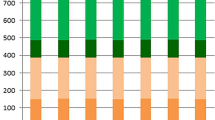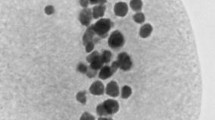Summary
The genetic constitution of the cell hybrids Atropa belladonna + Nicotiana chinensis, obtained by cloning of individual heteroplasmic protoplast fusion products (Gleba et al. 1982) and cultured in vitro for 12 months, has been studied. The study comprised 11 hybrid cell clones of independent origin and included analysis of a) chromosome number, size, morphology, and relative position in metaphase plates, b) multiple molecular forms of the enzymes esterase and amylase, and c) relative nuclear DNA content. The data obtained permit us to conclude that, after one year of unorganized growth in vitro, the cells of most (8) clones had retained chromosomes of both parents, while species-specific elimination of nearly all Atropa chromosomes had occurred in three clones. About half of the non-segregating clones possess 120–150 chromosomes including 50–70 of Atropa and 50–90 of Nicotiana. Other clones are polyploid and possess 200–250 chromosomes with a predominance of either Atropa or Nicotiana chromosome types. Only a few chromosomal changes (reconstituted chromosomes, ring chromosomes) have been detected. In some metaphase plates, chromosomes of the two parents tend to group separately, indicating non-random arrangement of chromosomes of the two parents within the hybrid nucleus. Cytophotometric studies of the relative nuclear DNA content showed that distribution histograms for cell clones were similar to those of non-hybrid cultured cells. Cell populations were relatively homogenous and do not indicate any genetic instability as a result of hybridization between remote plant species. Biochemical analysis of isoenzyme patterns confirmed that in most cell clones, species-specific multiple molecular forms of esterase and amylase from both parents were present, i.e. genetic material of both parental species was expressed in the cell hybrids.
Similar content being viewed by others
References
Brewbaker JL, Upadhya MD, Makinen Y, MacDonald T (1968) Isoenzyme polymorphism in flowering plants. 3. Gel electrophoretic methods and applications. Physiol Plant 21:930–940
Chien YC, Kao KN, Wetter LR (1982) Chromosomal and isozyme studies of Nicotiana tabacum — Glycine max hybrid cell lines. Theor Appl Genet 62:301–304
Constabel F, Weber G, Kirkpatrick JW (1977) Sur la compatibilite des chromosomes dans les hybrides intergeneriques de Glycine max X Vicia hajastana. CR Acad Sci Ser D 285:319–322
Davies BY (1967) Disc electrophoresis. 2. Method and application to human serum proteins. Ann NY Acad Sci 121:404–427
Dudits D, Fejer O, Hadlaczky G, Koncz GB, Horvath G (1980) Intergeneric gene transfer mediated by protoplast fusion. Mol Gen Genet 179:283–288
Dudits D, Hadlaczky GY, Bajszar GY, Koncz CS, Lazar G (1979) Plant regeneration from intergeneric cell hybrids. Plant Sci Lett 15:101–112
Finch RA, Smith JB, Bennett MD (1981) Hordeum and Secale genomes lie apart in a hybrid. J Cell Sci 52:391–403
Gamborg OL, Miller RA, Ojima K (1968) Nutrient requirements of suspension of soybean root cells. Exp Cell Res 50:151–158
Garcia AM, Iorio R (1966) Possible errors in two-wave length cytophotometry. In: Wied GL (ed) Introduction to quantitative cytochemistry. Academic Press, New York London, pp 178–194
Gleba Yu, Hoffmann F (1978) Hybrid cell lines Arabidopsis thaliana + Brassica campestris: no evidence for specific chromosome elimination. Mol Gen Genet 165:257–264
Gleba Yu, Hoffmann F (1979) “Arabidobrassica”: Plant genome engineering by protoplast fusion. Naturwissenschaften 66:547–564
Gleba Yu, Hoffmann F (1980) “Arabidobrassica”: a novel plant obtained by protoplast fusion. Planta 149:112–117
Gleba Yu, Momot VP, Cherep NN, Skarzhynskaya MV (1982) Intertribal hybrid cell lines of Atropa belladonna (X) Nicotiana chinensis obtained by cloning individual protoplast fusion products. Theor Appl Genet 62:75–79
Gleba Yu, Okolot AN, Momot VP, Cherep NN (1983 a) Isolation of hybrid cell line Pisum sativum (X) Nicotiana chinensis (submitted)
Gleba Yu, Okolot AN, Momot VP, Cherep NN, Skarzhynskaya MV (1983 b) Somatic hybrids Atropa belladonna (X) Nicotiana tabacum obtained by cloning individual heterokaryocites. Plant Cell Rep (in press)
Kao KN (1977) Chromosomal behavior in somatic hybrids of soybean-Nicotiana glauca. Mol Gen Genet 150:225–230
Krumbiegel G, Schieder O (1979) Selection of somatic hybrids after fusion of protoplasts from Datura innoxia and Atropa belladonna. Planta 145:371–375
Krumbiegel G, Schieder O (1981) Comparison of somatic and sexual incompatibility between Datura innoxia and A tropa belladonna. Planta 153:466–470
Medgyesy P, Menczel L, Maliga P (1980) The use of cytoplasmic streptomycin resistance: chloroplast transfer from Nicotiana tabacum into Nicotiana sylvestris, and isolation of their somatic hybrids. Mol Gen Genet 179:693–698
Mendelsohn ML (1969) Absorption cytophotometry. In: Wied GL (ed) Introduction to quantitative cytochemistry. Academic Press, New York London, pp 47–59
Pugachev VS (1979) Probability theory and mathematical statistics. Nauka Publ House, Moscow (in Russian)
Skarzhynskaya MV, Cherep NN, Gleba Yu (1982) Potato + tobacco hybrid cell lines and plants obtained by cloning individual protoplast fusion products. Tsitol Genet (in press)
Wetter LR (1977) Isoenzyme patterns in soybean-Nicotiana hybrid cell lines. Mol Gen Genet 150:231–235
Wetter LR, Kao KN (1980) Chromosome and isoenzyme studies on cells derived from protoplast fusion of Nicotiana glauca with Glycine max-Nicotiana glauca cell hybrids. Theor Appl Genet 57:273–276
Author information
Authors and Affiliations
Additional information
Communicated by H. F. Linskens
Dedicated to Professor G. Melchers with gratitude
Rights and permissions
About this article
Cite this article
Gleba, Y.Y., Momot, V.P., Okolot, A.N. et al. Genetic processes in intergeneric cell hybrids Atropa + Nicotiana . Theoret. Appl. Genetics 65, 269–276 (1983). https://doi.org/10.1007/BF00276562
Received:
Issue Date:
DOI: https://doi.org/10.1007/BF00276562




